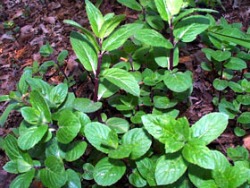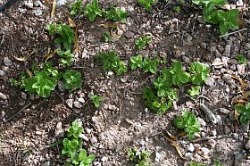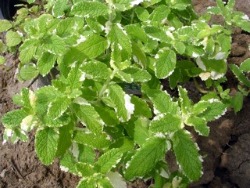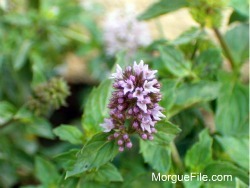Edible of the Month: Mint

Peppermint is a widely grown mint that tastes great in drinks and foods. However, it's aggressive and needs containment or it can take over.

Mint has the ability to grow in full sun or part shade. It's creeping nature makes is a great ground cover.
There is a mint for almost any taste you can imagine. Some the flavors of mint include spearmint, apple mint, orange mint, ginger mint, peppermint, lavender mint, pineapple mint, banana mint, and chocolate mint. It's regular candy store of flavors! Mint can be used fresh in drinks, and cooked into a wide variety of dishes including salads, soups, meats, and desserts.
Mint also is one of the herbs that, once you start growing it, you can't stop. Or should I say, it won't let you stop. Mint has a reputation for being aggressive and spreading throughout a bed. Trying to eradicate it from an area can be difficult. However, it really
depends on the type of mint you're growing. Some mints, such as pineapple mint and banana mint, are less aggressive than the
traditional varieties, such as peppermint. Fear not the mint. There are ways even aggressive growing ones can be contained to provide flavorful leaves without dominating the landscape.
Mint is a versatile, low growing plant as well. It can grow in a traditional herb garden, mixed with other perennials, in a vegetable garden, in containers, or even in walkways (e.g. Corsican mint). Not only is it a great ground cover, but the flowers are beautiful and highly attractive to bees.
Planning
Mint grows in just about any climate. If growing in an herb or flower garden, make sure you either have ways to limit its spread, plant less aggressive varieties, or plant where you don't mind it rambling. Mint makes an excellent ground cover and since it tolerates part shade, can be grown under trees and shrubs as well. However, it does need moisture to thrive, so gardeners in dry climates need to make sure there's a good water supply or grow varieties tolerant of dry conditions, such as Japanese mint.
Here are some of the best varieties to try in your garden. All grow 1- to 3-feet tall and spread unless otherwise noted.
'Apple mint' – This mint has a strong green-apple fragrance and makes a great tea and addition to fruit salad.
'Banana mint' – A low growing (6 inches tall) mint with round, furry leaves, it's not as aggressive as other varieties. Its banana-like flavor is good in tea, ice cream, and cookies.
'Chocolate mint' – A type of peppermint, the dark green leaves have a definite chocolate fragrance combined with the refreshing qualities of peppermint.
'Corsican mint' – This mint only grows 3/4-inch tall with small rounded leaves and a peppermint scent. It needs a cool, moist, shady area to grow, but makes a perfect plant to grow between stepping stones
in a walkway.
'Ginger mint' – A colorful green-and-yellow foliaged mint with red stems. It has a spearmint-like fragrance and is good used in fruit salads with melons. It likes a cool, shady place to grow.
'Lavender mint' – This mint features grey-green leaves with purple undersides and a lavender scent. It's good for potpourris.
'Peppermint' – Traditionally used for tea, it has pink flowers and a strong fragrance. It also can be used medicinally. Japanese mint is a version of peppermint with high oil content and the ability to grow in
a wide variety of climates.
'Pineapple mint' – A white-and-green variegated leaf mint that is less aggressive than others and beautiful in the landscape. A good variety for potpourris.
'Spearmint' – This traditional variety has been used for centuries in cooking meats, and more recently, to make mint juleps.
Preparation
Some, such as Corsican mint, like a cool, wet, shady area to grow. However, most varieties thrive on well-drained, moist soil in full sun. But, they aren't picky. I've grown mint in part shade on clay soil and it did fine. You can start plants from seed, but it's much easier to buy, divide, or root desired varieties to create small plants.
Planting

Variegated mint is less aggressive than the green leafed version and is a striking plant in the garden.

Mint also has beautiful flowers that make it attractive and a plant bees love.
Amend the soil well before planting with compost to help keep the soil moist. Remove all weeds, especially perennial ones, from the area, since it's painstaking to weed mint plants once planted. Set mint plants in the garden spaced 1- to 2-feet apart after all danger of frost has passed in your area. Mulch plants with bark or straw mulch to
keep the soil moist and weed free. If you want to grow mint from seed, sow indoors 8 weeks before you'll be transplanting outdoors.
If you want to avoid having your mint take over, plant varieties in bottomless pots sunk into the ground. The underground rhizomes won't be able to spread as aggressively.
Mint also grows well as an indoor herb plant. Move potted mint plants indoors before a killing frost. Give them plenty of light, cut back on watering in winter, and you'll get plants from which you can harvest some leaves in winter and plant back into the garden in spring.
Care
Mint requires little care to keep it growing. If planting a patch of different types of mint, keep the more aggressive ones from taking over by containing them, or by digging and dividing them annually in spring.
Mint varieties will cross pollinate but it will only affect the
seedlings that grow from the seeds that develop as a result of the pollination. Pull out seedlings or you'll get hybrids that won't taste like the mother plant. Also, if allowed to grow together, it may be
hard to distinguish one mint variety from another when picking.
To share your mints, in spring dig and divide mother plants. Mint also readily roots from cuttings. Snip a 4- to 6-inch cutting from the mother plant, dip the cut end in rooting hormone powder, remove all but the top set of leaves, stick the cuttings in a pot filled with moistened potting soil, and place in a bright room, out of direct sun. Cuttings should root in about 2 weeks.
In fall, cut back plants, especially aggressive ones, to limit their growth and remove any diseased leaves. Mints generally don't have problems with insects and diseases, but sometimes rust disease will attack and can be controlled by removing and destroying the leaves in fall.
Harvest
Harvest mint leaves as needed once the plant is established. For fresh use, pick the youngest leaves before the plant flowers, just after the dew dries in the morning for best flavor. If harvesting for
drying, cut 6-inch long mint stems, bunch them together, and hang them in a well ventilated, 70 degree F, airy room out of direct sunlight. Place a brown paper bag around the bunch to retain the leaves color and oil content. They should be dry in about 1 to 2 weeks.
You can also dry mint leaves in an oven set at 185 degrees F, a microwave, or food dehydrator. Watch leaves carefully so they don't burn.
Views: 5
© 2025 Created by Aggie.
Powered by
![]()